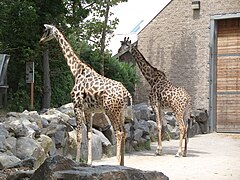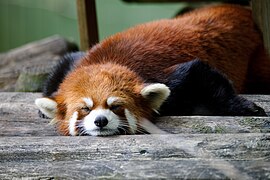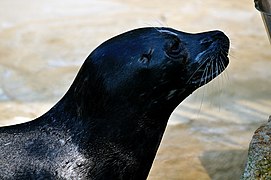
Roger Williams Park Zoo
The Roger Williams Park Zoo of Providence, Rhode Island, contains more than 800 animals in natural settings from a total of 160 species from around the world. In 1986, the zoo became the first zoo in New England to earn accreditation from the Association of Zoos and Aquariums. Founded in 1872, the zoo is the third oldest zoo in the nation.[4] The zoo and the nearby Carousel Village are some of the main attractions of Roger Williams Park.
Roger Williams Park Zoo
Providence, Rhode Island, United States
40 acres[4]
800[5]
160[5]
834,960[6]
Alex and Ani Farmyard, Fabric of Africa, Jambo Junction, Faces of the Rainforest, Feinstein Junior Scholar Wetlands Trail, Marco Polo's Adventure Trek, North America, Our Big Backyard, World of Adaptations
History[edit]
The Roger Williams Park Zoo first opened in 1872 as a limited collection of small animals, including raccoons, guinea pigs, mice, squirrels, rabbits, hawks, peacocks, and anteaters. Its first building was the Menagerie which opened in 1890. In the 1900s, the facility began to spread out over the entire park, featuring a variety of animals such as monkeys, hoofstock, bears, and big cats. In 1929, the Menagerie building was converted to a birdhouse; this was followed by the opening of an elephant barn in 1930 (which would later be converted to the Tropical America building). In the 1930s, a new sea lion pool was constructed. Bunny Village opened in 1949, one of the zoo's most popular exhibits.
In the mid-1960s, the zoo started to show signs of neglect. In 1962, Sophie Danforth founded the Rhode Island Zoological Society to increase public awareness of the neglect and to raise funds for improvement, and it remains the organization that supports and manages the zoo. The society opened a gift shop and food concessions in 1970, and all funds benefited the zoo.[2] The zoo closed from 1978 to 1980 to undertake an upgrade project. A children's nature center was added, as well as a naturalistic polar bear exhibit, a boardwalk through a wetlands area, and a North American bison exhibit. In the 1980s, a South American Pampas exhibit and a lemur exhibit were built. In 1986, the zoo's old stable/barn - which for many years had been home to the park's workhorses - was converted into an animal hospital, education department, and administrative offices. As a result, the zoo became the first in New England to receive accreditation from the Association of Zoos and Aquariums.[2]
In 1987, a new master plan was formulated to dramatically expand the zoo. Over time, many new exhibits were built, including a new sea lion exhibit (1987), a Humboldt penguin exhibit (1988), Plains of Africa (1991–93), Madagascar (1995), and Marco Polo Trail (1996). In 1989, the old Menagerie building was once again renovated, this time into a new gift shop. A new veterinary hospital opened in the spring of 2011. Hasbro's Our Big Backyard opened in 2012 as an interactive play space, with a second phase completed in 2014 featuring native New England animals. In the summer of 2012, the zoo opened new exhibits for takins, red river hogs, and king vultures.[7]
A new master plan was unveiled in 2015 for the next 20 years. It includes constructing a new rainforest building to be completed in 2018, a new exhibit for California sea lions and Humboldt penguins, a shorebird aviary, and a new tiger habitat. A complete reworking of the North America exhibit will feature grizzly bears, moose, and bighorn sheep.[8][9]
The zoo is home to more than 150 rare and fascinating animals from around the world. Major exhibits at the zoo include:









